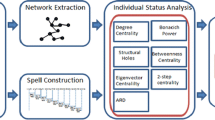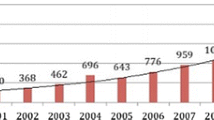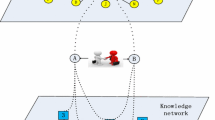Abstract
Given the global increase in public funding for nanotechnology research and development, it is even more important to support projects with promising return on investment. A main return is the benefit to other researchers and to the entire field through knowledge diffusion, invention, and innovation. The social network of researchers is one of the channels through which this happens. This study considers the scientific publication network in the field of nanotechnology, and evaluates how knowledge diffusion through coauthorship and citations is affected in large institutions by the location and connectivity of individual researchers in the network. The relative position and connectivity of a researcher is measured by various social network metrics, including degree centrality, Bonacich Power centrality, structural holes, and betweenness centrality. Leveraging the Cox regression model, we analyzed the temporal relationships between knowledge diffusion and social network measures of researchers in five leading universities in the United States using papers published from 2000 to 2010. The results showed that the most significant effects on knowledge diffusion in the field of nanotechnology were from the structural holes of the network and the degree centrality of individual researchers. The data suggest that a researcher has potential to perform better in knowledge creation and diffusion on boundary-spanning positions between different communities and when he or she has a high level of connectivity in the knowledge network. These observations may lead to improved strategies in planning, conducting, and evaluating multidisciplinary nanotechnology research. The paper also identifies the researchers who made most significant contributions to nanotechnology knowledge diffusion in the networks of five leading U.S. universities.

Similar content being viewed by others
Notes
National Science Foundation, Nanotechnology definition (NSET, February 2000). URL: http://www.nsf.gov/crssprgm/nano/reports/omb_nifty50.jsp, accessed on 2 May 2014.
References
Ahuja G (2000) Collaboration networks, structural holes, and innovation: a longitudinal study. Adm Sci Q 45(3):425–455
Bonacich P (1987) Power and centrality: a family of measures. Am J Sociol 92:1170–1182
Burt RS (1992) Structural Holes: the social structure of competition. Harvard University Press, Cambridge
Chen H, Roco MC (2009) Map** nanotechnology innovations and knowledge: global and longitudinal patent and literature analysis. Springer, Berlin
Chen H, Roco MC, Son J (2013a) Nanotechnology public funding and impact analysis: a tale of two decades (1991–2010). IEEE Nanotechnol 7(1):9–14
Chen H, Roco MC, Son J, Jiang S, Larson C, Gao Q (2013b) Global nanotechnology development from 1991 to 2012: patents, scientific publications, and effect of NSF funding. J Nanopart Res 15(9):1–21
Cox DR (1972) Regression models and life tables. JR stat soc B 34(2):187–220
Ding Y (2011) Scientific collaboration and endorsement: network analysis of coauthorship and citation networks. J Informetr 5(1):187–203
Fleming L (2001) Recombinant uncertainty in technological search. Manag Sci 47(1):117–132
Freeman LC (1979) Centrality in social networks: conceptual clarification. Soc Netw 3:215–239
Gondal N (2011) The local and global structure of knowledge production in an emergent research field: an exponential random graph analysis. Soc Netw 33(1):20–30
Huang Z, Chen H, Yan L, Roco MC (2005) Longitudinal nanotechnology development (1991–2002): National Science Foundation funding and its impact on patents. J Nanopart Res 7(4–5):343–376
Huang Z, Chen H, Li X, Roco MC (2006) Connecting NSF funding to patent innovation in nanotechnology (2001–2004). J Nanopart Res 8(6):859–879
Jiang S, Gao Q, Chen H (2013) Statistical modeling of nanotechnology knowledge diffusion networks. In: Proceedings of 34th international conference on information systems, Milan
Kretschmer H (2004) Author productivity and geodesic distance in bibliographic co-authorship networks, and visibility on the Web. Scientometrics 60(3):409–420
Li X, Chen H, Dang Y, Lin Y, Larson CA, Roco MC (2008) A longitudinal analysis of nanotechnology literature: 1976–2004. J Nanopart Res 10:3–22
Liu X, Zhang PZ, Li X, Chen H, Dang Y, Larson CA, Roco MC, Wang XW (2009) Trends for nanotechnology development in China, Russia, and India. J Nanopart Res 11(8):1845–1866
Liu X, Kaza S, Zhang P, Chen H (2011) Determining inventor status and its effect on knowledge diffusion: a study on nanotechnology literature from China, Russia, and India. J Am Soc Inform Sci Technol 62(6):1166–1176
Lux Research (2014) Nanotechnology update: corporations up their spending as revenues for nano-enabled products increase. Private communication
Nerkar A, Paruchuri S (2005) Evolution of R&D capabilities: the role of knowledge networks within a firm. Manag Sci 51(5):771–785
Newman MEJ (2001) From the cover: The structure of scientific collaboration networks. Proc Natl Acad Sci 98(2):404–409
Newman MEJ (2005) A measure of betweenness centrality based on random walks. Soc Netw 27:39–54
Podolny JM, Stuart TE (1995) A role-based ecology of technological change. Am J Sociol 100(5):1224–1260
Roco MC (2011) Nanotechnology: from discovery to innovation and socioeconomic projects. CEP, AIChE, pp 21–27
Roco MC, Bainbridge WS (2013) The new world of discovery, invention and innovation: convergence of knowledge, technology and society. J Nanopart Res 15(1946):1–17
Roco MC, Mirkin C, Hersam MC (2011) Nanotechnology research directions for societal needs in 2020. J Nanopart Res 13(3):897–919
Shapira P, Wang J (2010) Follow the money. Nature 468(7324):627–628
Singh J (2007) External collaboration, social networks and knowledge creation: evidence from scientific publications. Danish Research Unit of Industrial Dynamics Summer Conference 2007
Sorenson O, Stuart TE (2001) Syndication networks and the spatial distribution of venture capital investments. Am J Sociol 106(6):1546–1588
Wang J, Shapira P (2011) Funding acknowledgement analysis: an enhanced tool to investigate research sponsorship impacts: the case of nanotechnology. Scientometrics 87(3):563–586
Acknowledgments
This study was supported by the U.S. National Science Foundation (CMMI-1057624 and CMMI-1249210), and the National Natural Science Foundation of China (Grants Number: 71101053, 61104139, 71171131, and 71103021). The last co-author was supported by the Directorate of Engineering, NSF.
Author information
Authors and Affiliations
Corresponding authors
Rights and permissions
About this article
Cite this article
Liu, X., Jiang, S., Chen, H. et al. Nanotechnology knowledge diffusion: measuring the impact of the research networking and a strategy for improvement. J Nanopart Res 16, 2613 (2014). https://doi.org/10.1007/s11051-014-2613-x
Received:
Accepted:
Published:
DOI: https://doi.org/10.1007/s11051-014-2613-x




